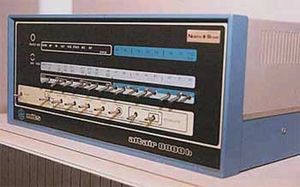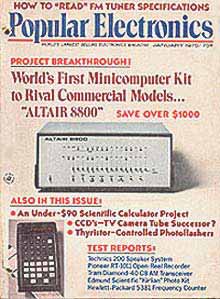Altair: Difference between revisions
No edit summary |
m (Text replace - "[[Category:Computers and information processing" to "[[Category:Computing and electronics") |
||
| (6 intermediate revisions by 2 users not shown) | |||
| Line 1: | Line 1: | ||
== Altair, Computer in a Kit == | == Altair, Computer in a Kit == | ||
[[Image:Altair 1.jpg|thumb| | [[Image:Altair 1.jpg|thumb|right|Altair 8800, a computer in a kit. Buyers had to assemble Altair themselves. The computer had no keyboard and no display; it was programmed with the switches on the front panel. Courtesy: Computer Museum of America.]] | ||
The development of the [[Early Microprocessors|microprocessor]] by the Intel Corporation made it possible to build an inexpensive personal computer. The microprocessor is a complex circuit, built into a single chip of silicon, that can perform the basic functions of a computer. Intel had designed a microprocessor (the first one was the 4004, delivered in 1971) for use in a scientific calculator. | |||
[[Image:Altair 2.jpg|thumb|right|A 1975 edition of Popular Electronics announcing Altair.]] | |||
Though the microprocessor made an inexpensive personal computer a possibility, | Though the microprocessor made an inexpensive personal computer a possibility, no company hurried to develop such a product. It was computer hobbyists who first built such a device, and the first hobbyist kit for a microprocessor-based computer was the Altair 8800—which used the Intel 8800 chip—offered for the first time in January 1975. It was inexpensive, about $400, but the hobbyist had to construct it himself and it was difficult to use. There was no keyboard or display; the hobbyist programmed the computer using a panel of switches and read the output from a panel of neon bulbs. Nevertheless, the Altair attracted a great deal of attention, and entrepreneurs developed supplementary equipment and software to make it easier to use. Two years later, in 1977, an easy-to-use, inexpensive, and fully assembled computer—the Apple II—became available. | ||
[[Category:Computing and electronics|Category:Components,_circuits,_devices_&_systems]] | |||
[[Category:News]] | |||
Revision as of 15:57, 22 July 2014
Altair, Computer in a Kit
The development of the microprocessor by the Intel Corporation made it possible to build an inexpensive personal computer. The microprocessor is a complex circuit, built into a single chip of silicon, that can perform the basic functions of a computer. Intel had designed a microprocessor (the first one was the 4004, delivered in 1971) for use in a scientific calculator.
Though the microprocessor made an inexpensive personal computer a possibility, no company hurried to develop such a product. It was computer hobbyists who first built such a device, and the first hobbyist kit for a microprocessor-based computer was the Altair 8800—which used the Intel 8800 chip—offered for the first time in January 1975. It was inexpensive, about $400, but the hobbyist had to construct it himself and it was difficult to use. There was no keyboard or display; the hobbyist programmed the computer using a panel of switches and read the output from a panel of neon bulbs. Nevertheless, the Altair attracted a great deal of attention, and entrepreneurs developed supplementary equipment and software to make it easier to use. Two years later, in 1977, an easy-to-use, inexpensive, and fully assembled computer—the Apple II—became available.

